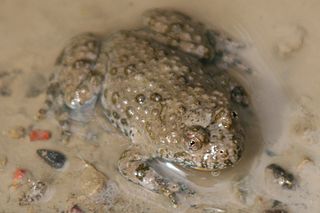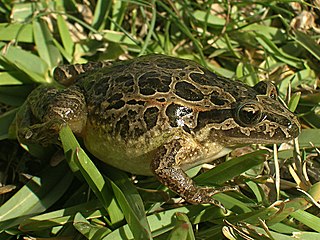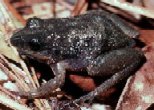
The fire-bellied toads are a group of six species of small frogs belonging to the genus Bombina.

The European fire-bellied toad is a species of fire-bellied toad native to eastern parts of mainland Europe, where it can be found near waterbodies such as ponds and marshes. It is known for its red colored belly used to ward off predators, an example of aposematism, and its distinctive "whoop" call.

The Altamira yellowthroat is a New World warbler. It is a resident breeding bird endemic to the Gulf slope of northeastern Mexico.

The yellow-bellied toad belongs to the order Anura, the archaeobatrachial family Bombinatoridae, and the genus of fire-bellied toads. The toad is distributed mainly across western Europe as well as a handful of countries in eastern Europe. While the population of the toad is steadily decreasing over time, its numbers are not critical enough to be considered threatened or extinct. Conservation efforts in Germany are taking place to remedy the declining population before it is too late.

The Oriental fire-bellied toad is a small semiaquatic frog species found in northeastern Asia, where they primarily dwell in slow-moving bodies of water and temperate forests. Quite common throughout much of their range, these frogs have mild toxins that can be excreted through their skin, with their vibrant underbellies serving as a warning of this. While not a true toad, their green and black skin is covered in small tubercles, giving them a toadlike appearance. Their sounds, mainly produced by males during the mating season, are very unlike those of other frogs. While their population is in decline, their numbers are still high overall, with the International Union for Conservation of Nature (IUCN) rating them as a least-concern species. They are commonly kept as pets in land and water vivaria, as a relatively easy-to-care for species. They are also frequently used in scientific research, with their behavior, vocalizations, and learning skills all moderately studied.

The Carpathian newt, or Montandon’s newt, is a species of salamander in the family Salamandridae found in Czech Republic, Poland, Romania, Slovakia, and Ukraine.
Bombina maxima, commonly known as the Yunnan firebelly toad or large-webbed bell toad, is a species of toad in the family Bombinatoridae found in Yunnan, China and likely to Myanmar. Its natural habitats include swamps, springs, marshes, arable land, canals, and ditches. Although easy to care for, handling a large-webbed toad should be kept to a minimum because their skin secretes a toxin that can cause irritation
Bombina microdeladigitora is a species of toad in the family Bombinatoridae endemic to Guangxi, Hubei and Sichuan in China. It is commonly known by several names including Guangxi firebelly toad, Hubei firebelly toad, large-spined bell toad, Lichuan bell toad, small-webbed bell toad, and Yunnan firebelly toad. Its natural habitats are subtropical or tropical moist montane forests, temperate forests, rivers, swamps, and freshwater marshes. It is threatened by habitat loss.

The African common toad or guttural toad is a species of toad in the family Bufonidae. It is found in Angola, Botswana, Democratic Republic of the Congo, Kenya, Lesotho, Malawi, Mauritius, Mozambique, Namibia, Réunion, Somalia, South Africa, Ethiopia, Eswatini, Tanzania, Zambia, and Zimbabwe. Its natural habitats are subtropical or tropical dry forest, subtropical or tropical moist lowland forest, subtropical or tropical moist montane forest, dry savanna, moist savanna, temperate shrubland, subtropical or tropical dry shrubland, subtropical or tropical moist shrubland, subtropical or tropical dry lowland grassland, subtropical or tropical seasonally wet or flooded lowland grassland, subtropical or tropical high-altitude grassland, intermittent rivers, freshwater lakes, intermittent freshwater lakes, freshwater marshes, intermittent freshwater marshes, arable land, pastureland, rural gardens, urban areas, heavily degraded former forest, ponds, and canals and ditches.

The Japanese common toad, Japanese warty toad or Japanese toad is a species of toad in the family Bufonidae. It is endemic to Japan. Its natural habitats are subarctic forests, temperate forests, temperate shrubland, swamps, freshwater marshes, intermittent freshwater marshes, freshwater springs, arable land, rural gardens, urban areas, ponds, and irrigated land. Amplexus is the mating behaviour involved in the Japanese common toad during the breeding season.

The African red toad, or African split-skin toad, is a species of toad in the family Bufonidae. It is the only species of the monotypic genus Schismaderma. It is found in Angola, Botswana, Democratic Republic of the Congo, Eswatini, Kenya, Malawi, Mozambique, Namibia, South Africa, Tanzania, Zambia, Zimbabwe, and possibly Lesotho. Its natural habitats are dry savanna, moist savanna, subtropical or tropical dry shrubland, subtropical or tropical moist shrubland, subtropical or tropical dry lowland grassland, freshwater marshes, intermittent freshwater marshes, arable land, pastureland, urban areas, water storage areas, ponds, canals and ditches, and man-made karsts.

The Betic midwife toad or Sapo Partero Bético is a species of frog in the family Alytidae. It is endemic to mountainous in south eastern Spain. Its natural habitats are temperate forests, freshwater marshes, intermittent freshwater marshes, pastureland, ponds, and aquaculture ponds. It is threatened by habitat loss.

The Iberian painted frog is a species of frog in the family Alytidae. It is found in Portugal and Spain, where its natural habitats are temperate forests, temperate shrubland, Mediterranean-type shrubby vegetation, rivers, intermittent rivers, swamps, freshwater marshes, intermittent freshwater marshes, sandy shores, arable land, and grassland. It is threatened by habitat loss.

The southern chorus frog is a species of frog in the family Hylidae, endemic to the southeastern United States. Its natural habitats are temperate forests, temperate grassland, shrub-dominated wetlands, swamps, freshwater marshes, intermittent freshwater marshes, ponds, open excavations, seasonally flooded agricultural land, and canals and ditches. It is threatened by habitat loss.

Dyscophus antongilii, the Madagascar tomato frog, is a species of frog in the family Microhylidae.

The banded rubber frog is a species of frog in the family Microhylidae. It is found in central and southern Africa. Its natural habitats are dry savanna, moist savanna, subtropical or tropical dry shrubland, subtropical or tropical moist shrubland, subtropical or tropical dry lowland grassland, subtropical or tropical seasonally wet or flooded lowland grassland, subtropical or tropical high-altitude grassland, intermittent freshwater lakes, intermittent freshwater marshes, arable land, pastureland, water storage areas, ponds, and canals and ditches. The female can reach a maximum size of 65 mm whereas the tadpoles can reach a size of 37 mm. The maximum size of the male is yet unknown, but sizes differ from 45 mm to 68 mm.
Endemixit is a project that studies the effects of reduced population size in five Italian endemic species at risk of extinction. The final objective is to estimate the risk of extinction from genomic data and contribute to the preservation of these species. The project was funded by the MUR and coordinated by the Department of Life Sciences and Biotechnology of the University of Ferrara with the involvement of five other Italian universities: Ancona, Florence, Padua, Rome Tor Vergata and Trieste.
















